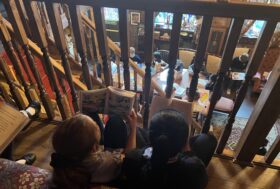Supporting refugee students in schools: What constitutes inclusive education?


This research summary is part of an online module on refugee education – Chartered College of Teaching members can access this learning for free.
This article summaries the following original research article:
Taylor S and Sidhu R (2012) Supporting refugee students in schools: What constitutes inclusive education? International Journal of Inclusive Education 16(1): 39–56.
Introduction
The aim of this study was to contribute to a greater understanding of how schooling can help to integrate refugee children into schools and the wider community. Schools face significant challenges if they are to contribute positively towards the inclusionAn approach where a school aims to ensure that all children of refugee students in their country of asylum. Refugees face many barriers to inclusion, including attitudinal barriers and racism, while the medicalisation of refugees as subjects of trauma may compound their marginalisation by relegating resilient survivors to welfare dependency.
Based on case studies of four schools, the strategies that they use to accommodate the needs of young people from refugee backgrounds are presented. Using these findings and other research, an inclusive model of good practice in refugee education is outlined.
What is the research underpinning it?
Four Australian schools were selected for this study. These schools were selected because of their reputation for working with refugee students. The analysis is based on an examination of policy documents and school prospectuses, along with interviews with principals and teachers. The schools reflect the diversityThe recognition of individual differences in terms of race, of Australia’s Catholic education system, which draws students from a broad cross-section of the Australian population.
Due to the limited sample size and the original aims of the research, the conclusions of this paper are inherently speculative. More research is therefore needed to gain a deeper understanding of how educational institutions might play a more active role in facilitating transitions to citizenship for refugee youths.
Impact on practice
Targeted policies are essential to address the educational disadvantages of refugee students. Without these policies, and corresponding budgetary support, individual schools and staff will have great difficulty in translating social justice ideals into practical programmes to support refugee students.
At a local level, key features of successful school programmes to support refugee students include:
- a commitment to social justice, evident through an ethos that celebrates diversity and the promotion of values such as respect, acceptance and responsibility for all
- a comprehensive support system to address the learning, social and emotional needs of refugee students and their families
- strong school leadership, typified by principals who promote positive images of refugee students within the school and local community
- an inclusive approach, typified by a culture of inclusion that celebrates refugee students as part of the multicultural and diverse fabric of the school; specific strategies to support refugee students to access the mainstream curriculum, such as the use of visual resources, may also be used – the challenge is finding an appropriate balance of supporting the special needs of the refugee students without ‘othering’ them
- a whole-school approach to learning assistance that focuses on including ESL (English as a second language) students in lessons, rather than withdrawing them from the mainstream class
- partnerships with community organisations to support refugee students’ social and emotional needs.
Key takeaways
- Issues relating to refugee education require targeted policy and systemic support
- Successful practices to support the schooling of young people from a refugee background are underpinned by an inclusive approach and a commitment to social justice
- Recognising the complexity of the needs of asylum seekers and refugee children, the schools in the study had comprehensive support systems in place to meet the academic, social and emotional needs of refugee students and their families.
Want to know more?
Arnot M and Pinson H (2005) The education of asylum-seeker and refugee children: A study of LEA and school values, policies and practices. Research Consortium on the Education of Asylum-Seeker and Refugee Children. Available at: www.educ.cam.ac.uk/people/staff/arnot/AsylumReportFinal.pdf (accessed 20 October 2022).
Cassity E and G Gow (2005) Shifting space and cultural place: The transition experiences of African young people in west Sydney schools. In: AARE Conference 2005, University of Western Sydney, Parramatta, 27 November–1 December 2005. Available at: www.aare.edu.au/data/publications/2005/cas05485.pdf (accessed 20 October 2022).
Rutter J (2006) Refugee Children in the UK. Maidenhead, Berkshire: Open University Press.









